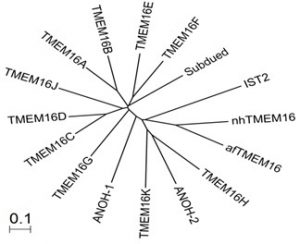Contents
A Short Course in TransMEMbrane Protein 16: What you Need to Know

The TransMEMbrane protein 16 (TMEM16) proteins are evolutionarily ancient and are expressed in different eukaryotic organisms from fungi to invertebrate to mammals. In mammals, the TMEM16 family comprises ten members (A, B, C, D, E, F, G, H, J and K).
Major functions of TMEM16 proteins
Significant progress has been made towards understanding TMEM16 proteins. Based on the current knowledge of vertebrate TMEM16s and their homologs in lower organisms, the functions of TMEM16 proteins are rather diverse. For example, a TMEM16 protein could be an intracellular membrane protein that regulates organelle interactions (such as yeast IST2), or serves as an ion channel (TMEM16A and TMEM16B), a lipid scramblase (fungal nhTMEM16), or both (TMEM16F and fungal afTMEM16) on the plasma membrane. Except TMEM16A, TMEM16B and TMEM16F, the functions of other mammalian TMEM16 family members still remain to be established.
A functional TMEM16 protein contains two subunits, each of which has 10 transmembrane (TM) segments with both the N- and C-terminus inside the cell.
Five highly conserved acidic residues and a less conserved asparagine residue in TM6, TM7 and TM8 form the calcium binding sites. In the nhTMEM16 structure, two calcium ions were coordinated by the side chain oxygen atoms from these residues. Interestingly, the calcium binding sites reside in the middle of a potentially aqueous ‘spiral staircase’ shaped subunit cavity that spans almost the entire membrane.
TMEM16 proteins in health and disease
Recent studies have begun to shed some light on the physiological and pathological roles of the 10 mammalian TMEM16 family members. Table 1 summarizes the current understanding of the TMEM16 proteins on human health and disease.
In addition to bioinformatics, early genetic analysis and expression profiling also implicated the importance of TMEM16 proteins in human health and disease (Table 1).
TMEM Protein in Health and Disease

Membrane ion and lipid transport in health and disease
The dynamic movement of ion and phospholipids across cell membranes controls numerous cellular processes, such as membrane excitability, ion homeostasis, volume regulation, secretion, cell signaling and cell-cell communication.
